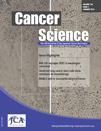Subpopulation of small-cell lung cancer cells expressing CD133 and CD87 show resistance to chemotherapy
Abstract
Tumors are presumed to contain a small population of cancer stem cells (CSCs) that initiate tumor growth and promote tumor spreading. Multidrug resistance in CSCs is thought to allow the tumor to evade conventional therapy. This study focused on expression of CD133 and CD87 because CD133 is a putative marker of CSCs in some cancers including lung, and CD87 is associated with a stem-cell-like property in small-cell lung cancer (SCLC). Six SCLC cell lines were used. The expression levels of CD133 and CD87 were analyzed by real-time quantitative reverse transcription-polymerase chain reaction and flow cytometry. CD133+/− and CD87+/− cells were isolated by flow cytometry. The drug sensitivities were determined using the 3-(4,5-dimethylthiazol-2-yl)-2,5-diphenyltetrazolium bromide assay. Non-obese diabetic/severe combined immunodeficiency mice were used for the tumor formation assay. SBC-7 cells showed the highest expression levels of both CD133 and CD87 among the cell lines. CD133−/CD87−, CD133+/CD87−, and CD133−/CD87+ cells were isolated from SBC-7 cells; however, CD133+/CD87+ cells could not be obtained. Both CD133+/CD87− and CD133−/CD87+ subpopulations showed a higher resistance to etoposide and paclitaxel and greater re-populating ability than the CD133−/CD87− subpopulation. CD133+/CD87− cells contained more G0 quiescent cells than CD133−/CD87− cells. By contrast, CD133−/CD87− cells showed the highest tumorigenic potential. In conclusion, both CD133 and CD87 proved to be inadequate markers for CSCs; however, they might be beneficial for predicting resistance to chemotherapy. (Cancer Sci 2013; 104: 78–84)




